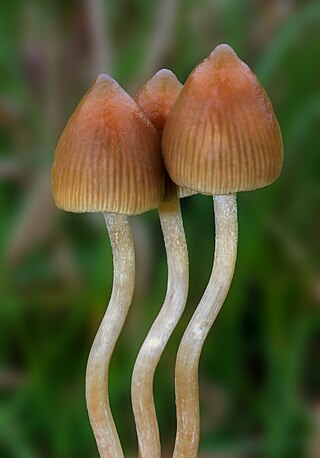Psilocybin Mushrooms (Psilocybe)
On this page... (hide)
- 1. Description
- 1.1 Types
- 2. Obtainment
- 3. Uses
- 3.1 Effects
- 4. More
- 5. 'Souls
| Common Name | Psilocybin Mushrooms |
| Latin Name | Psilocybe |
| Icon(s) | 
|
| Psilocybe semilanceata by Alan Rockefeller (Wikimedia Commons) | |
1. Description
There are approximately 190 species of psilocybin mushrooms and most of them fall in the genus Psilocybe. The majority of these are found in Mexico (53 species), with the remainder distributed in the US and Canada (22). In general, psilocybin-containing species are dark-spored, gilled mushrooms that grow in meadows and woods.
1.1 Types
- Liberty Cap: Native to Nova Scotia, they have a distinctive conical to bell-shaped cap, up to 2.5 cm (1.0 in) in diameter, with a small nipple-like protrusion on the top. They are yellow to brown in color, covered with radial grooves when moist, and fade to a lighter color as they mature. Their stems tend to be slender and long. The mushroom grows solitarily or in groups on the ground, typically in fields and pastures. It is often found in fields that have been fertilized with sheep or cow dung, although it does not typically grow directly on the dung. The mushroom is also associated with sedges in moist areas of fields.
- Teonanacatl: Brought northward to Nova Scotia, this is the species cultivated in Salsola. Ocherous to brown or beige to straw color in age, sometimes with blueish or greenish tones, easily turning blue when injured.
2. Obtainment
Common. The natural native is found most everywhere. Poisonous (sometimes lethal) wild picked mushrooms (ex. Galerina marginata) can be easily mistaken for psilocybin mushrooms.
Packs: Salsola has a large supply of these mushrooms in their pack garden.[1]
Foreign: Heavily used in Eterne.
3. Uses
The effects of psilocybin mushrooms come from psilocybin and psilocin. They create short-term increases in tolerance of users, thus making it difficult to abuse them because the more often they are taken within a short period of time, the weaker the resultant effects are. As with many psychedelic substances, the effects are subjective and can vary. Effects typically last anywhere from 3 to 8 hours.
3.1 Effects
Noticeable changes to the audio, visual, and tactile senses may become apparent around thirty minutes to an hour after ingestion. These shifts in perception visually include enhancement and contrasting of colors, strange light phenomena (such as auras or "halos" around light sources), increased visual acuity, surfaces that seem to ripple, shimmer, or breathe; complex open and closed eye visuals of form constants or images, objects that warp, morph, or change solid colours; a sense of melting into the environment, and trails behind moving objects. Sounds seem to be heard with increased clarity; music, for example, can often take on a profound sense of cadence and depth. Some users experience synesthesia, wherein they perceive, for example, a visualization of color upon hearing a particular sound.
4. More
5. 'Souls
- Something~

